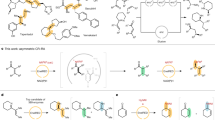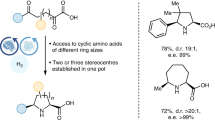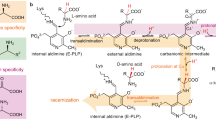Abstract
The use of transaminases to access pharmaceutically relevant chiral amines is an attractive alternative to transition-metal-catalysed asymmetric chemical synthesis. However, one major challenge is their limited substrate scope. Here we report the creation of highly active and stereoselective transaminases starting from fold class I. The transaminases were developed by extensive protein engineering followed by optimization of the identified motif. The resulting enzymes exhibited up to 8,900-fold higher activity than the starting scaffold and are highly stereoselective (up to >99.9% enantiomeric excess) in the asymmetric synthesis of a set of chiral amines bearing bulky substituents. These enzymes should therefore be suitable for use in the synthesis of a wide array of potential intermediates for pharmaceuticals. We also show that the motif can be engineered into other protein scaffolds with sequence identities as low as 70%, and as such should have a broad impact in the field of biocatalytic synthesis and enzyme engineering.
This is a preview of subscription content, access via your institution
Access options
Subscribe to this journal
Receive 12 print issues and online access
$259.00 per year
only $21.58 per issue
Buy this article
- Purchase on Springer Link
- Instant access to full article PDF
Prices may be subject to local taxes which are calculated during checkout



Similar content being viewed by others
References
Truppo, M. D., Rozzell, J. D. & Turner, N. J. Efficient production of enantiomerically pure chiral amines at concentrations of 50 g/L using transaminases. Org. Process Res. Dev. 14, 234–237 (2010).
Savile, C. K. et al. Biocatalytic asymmetric synthesis of chiral amines from ketones applied to sitagliptin manufacture. Science 329, 305–309 (2010).
Fuchs, M., Farnberger, J. E. & Kroutil, W. The industrial age of biocatalytic transamination. Eur. J. Org. Chem. 2015, 6965–6982 (2015).
Steffen-Munsberg, F. et al. Bioinformatic analysis of a PLP-dependent enzyme superfamily suitable for biocatalytic applications. Biotechnol. Adv. 33, 566–604 (2015).
Koszelewski, D., Tauber, K., Faber, K. & Kroutil, W. ω-Transaminases for the synthesis of non-racemic α-chiral primary amines. Trends Biotechnol. 28, 324–332 (2010).
Cassimjee, K. E., Branneby, C., Vahak, A., Wells, A. & Berglund, P. Transaminations with isopropyl amine: equilibrium displacement with yeast alcohol dehydrogenase coupled to in situ cofactor regeneration. Chem. Commun. 46, 5569–5571 (2010).
Koszelewski, D., Lavandera, I., Clay, D., Rozzell, D. & Kroutil, W. Asymmetric synthesis of optically pure pharmacologically relevant amines employing ω-transaminases. Adv. Synth. Catal. 350, 2761–2766 (2008).
Green, A. P., Turner, N. J. & O'Reilly, E. Chiral amine synthesis using ω-transaminases: an amine donor that displaces equilibria and enables high-throughput screening. Angew. Chem. Int. Ed. 53, 10714–10717 (2014).
Höhne, M., Schätzle, S., Jochens, H., Robins, K. & Bornscheuer, U. T. Rational assignment of key motifs for function guides in silico enzyme identification. Nature Chem. Biol. 6, 807–813 (2010).
Desai, A. A. Sitagliptin manufacture: a compelling tale of green chemistry, process intensification, and industrial asymmetric catalysis. Angew. Chem. Int. Ed. 50, 1974–1976 (2011).
Han, S.-W., Park, E.-S., Dong, J.-Y. & Shin, J.-S. Mechanism-guided engineering of ω-transaminase to accelerate reductive amination of ketones. Adv. Synth. Catal. 357, 1732–1740 (2015).
Sayer, C. et al. The substrate specificity, enantioselectivity and structure of the (R)-selective amine: pyruvate transaminase from Nectria haematococca. FEBS J. 281, 2240–2253 (2014).
Jiang, J., Chen, X., Feng, J., Wu, Q. & Zhu, D. Substrate profile of an ω-transaminase from Burkholderia vietnamiensis and its potential for the production of optically pure amines and unnatural amino acids. J. Mol. Catal. B 100, 32–39 (2014).
Nobili, A. et al. Engineering the active site of the amine transaminase from Vibrio fluvialis for the asymmetric synthesis of aryl–alkyl amines and amino alcohols. ChemCatChem 7, 757–760 (2015).
Genz, M. et al. Alteration of the donor/acceptor spectrum of the (S)-amine transaminase from Vibrio fluvialis. Int. J. Mol. Sci. 16, 26953–26963 (2015).
Steffen-Munsberg, F. et al. Connecting unexplored protein crystal structures to enzymatic function. ChemCatChem 5, 150–153 (2013).
Middelfort, K. S. et al. Redesigning and characterizing the substrate specificity and activity of Vibrio fluvialis aminotransferase for the synthesis of imagabalin. Protein Eng. Des. Sel. 26, 25–33 (2013).
Kaulmann, U., Smithies, K., Smith, M. E. B., Hailes, H. C. & Ward, J. M. Substrate spectrum of ω-transaminase from Chromobacterium violaceum DSM30191 and its potential for biocatalysis. Enzyme Microb. Technol. 41, 628–637 (2007).
Cassimjee, K. E., Humble, M. S., Land, H., Abedi, V. & Berglund, P. Chromobacterium violaceum ω-transaminase variant Trp60Cys shows increased specificity for (S)-1-phenylethylamine and 4′-substituted acetophenones, and follows Swain–Lupton parameterisation. Org. Biomol. Chem. 10, 5466–5470 (2012).
Steffen-Munsberg, F. et al. Revealing the structural basis of promiscuous amine transaminase activity. ChemCatChem 5, 154–157 (2013).
Cassimjee, K. E., Manta, B. & Himo, F. A quantum chemical study of the ω-transaminase reaction mechanism. Org. Biomol. Chem. 13, 8453–8464 (2015).
Yu, H., Zhao, Y., Guo, C., Gan, Y. & Huang, H. The role of proline substitutions within flexible regions on thermostability of luciferase. Biochim. Biophys. Acta Prot. Proteomics 1854, 65–72 (2015).
Deszcz, D. et al. Single active-site mutants are sufficient to enhance serine:pyruvate α-transaminase activity in an ω-transaminase. FEBS J. 282, 2512–2526 (2015).
Wilke, A. et al. The M5nr: a novel non-redundant database containing protein sequences and annotations from multiple sources and associated tools. BMC Bioinformatics 13, 141 (2012).
Levin, K. B. et al. Following evolutionary paths to protein–protein interactions with high affinity and selectivity. Nature Struct. Mol. Biol. 16, 1049–1055 (2009).
Shafee, T., Gatti-Lafranconi, P., Minter, R. & Hollfelder, F. Handicap-recover evolution leads to a chemically versatile, nucleophile-permissive protease. ChemBioChem 16, 1866–1869 (2015).
Grishin, N. V., Phillips, M. A. & Goldsmith, E. J. Modeling of the spatial structure of eukaryotic ornithine decarboxylases. Protein Sci. 4, 1291–1304 (1995).
Schätzle, S., Höhne, M., Redestad, E., Robins, K. & Bornscheuer, U. T. Rapid and sensitive kinetic assay for characterization of ω-transaminases. Anal. Chem. 81, 8244–8248 (2009).
Acknowledgements
The authors thank J.F. Kabisch for preparing the M5nr database, M. Althaus and I. Duffour for developing the chiral and achiral analysis methods, J. Joerger and M. Rothe for the preparative separation of the chiral amines, C. Wyss-Gramberg for the NMR analysis of the Mosher amides, I. Menyes for support with HPLC and gas chromatography analyses and P. Meier for performing the preparative asymmetric synthesis experiments.
Author information
Authors and Affiliations
Contributions
U.T.B., H.I. and B.W. initiated the study and directed the project. P.S. undertook the substrate and product syntheses. I.V.P. performed the bioinformatics analysis. I.V.P., M.S.W. and M.G. prepared and characterized all the variants. I.V.P, S.P.H. and H.I. performed the preparative asymmetric synthesis experiments. I.V.P., H.I. and U.T.B. prepared the manuscript, which was revised and approved by all authors.
Corresponding authors
Ethics declarations
Competing interests
The biocatalysis group of Roche has a committed interest over the long term in establishing a set of technically applicable TAs with broad substrate acceptance to assist devising more attractive, shorter, economical and greener synthetic routes to investigational drugs and beyond.
Supplementary information
Supplementary information
Supplementary information (PDF 1963 kb)
Rights and permissions
About this article
Cite this article
Pavlidis, I., Weiß, M., Genz, M. et al. Identification of (S)-selective transaminases for the asymmetric synthesis of bulky chiral amines. Nature Chem 8, 1076–1082 (2016). https://doi.org/10.1038/nchem.2578
Received:
Accepted:
Published:
Issue Date:
DOI: https://doi.org/10.1038/nchem.2578
This article is cited by
-
Characterization of proteins from the 3N5M family reveals an operationally stable amine transaminase
Applied Microbiology and Biotechnology (2022)
-
Direct 1,3-butadiene biosynthesis in Escherichia coli via a tailored ferulic acid decarboxylase mutant
Nature Communications (2021)
-
Catalytic enantioselective synthesis of β-amino alcohols by nitrene insertion
Science China Chemistry (2021)
-
Redesign of (R)-Omega-Transaminase and Its Application for Synthesizing Amino Acids with Bulky Side Chain
Applied Biochemistry and Biotechnology (2021)
-
The combination of asymmetric hydrogenation of olefins and direct reductive amination
Nature Communications (2020)



